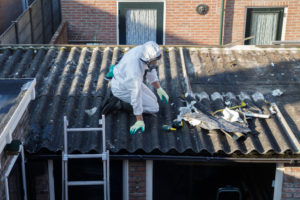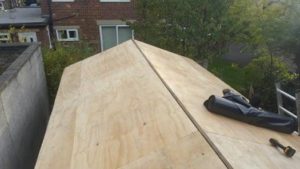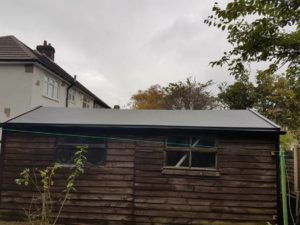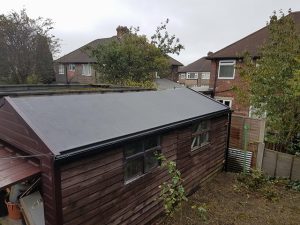Protect your workforce and your property with our professional asbestos removal service at Flat Roof Experts. It’s not uncommon to find asbestos in older roofing materials or disused buildings, and our team are here to help make your property safe and compliant with new, secure roofing.
Whether you want to restore a disused garage or refurbish a commercial building, our experts will work with you to refresh your property with a long-term roofing solution across the Leeds and Bradford area.
Explore how we can help transform your roofing below.
Why choose Flat Roof Experts for your asbestos roof removal?
Custom services for any property
We know that every building is different, and so are your roofing needs. The level of repairs and restoration your roof needs depends on a number of factors, and our team will assess and survey your property and create a tailored repair plan, complete with a quote on the cost for the project.
A range of comprehensive roofing solutions
Alongside removing asbestos, we also offer a full range of roofing services and upgrades to ensure your roof is best suited to your environment and property needs. We offer:
- Premium EPDM rubber roofing installation
- Green roof installation for an eco-friendly roofing solution
- Full refurbishments, repairs or roof extensions
- Soffit and fascia repairs
Reliable roofing experts for over 25 years
We’ve been helping homeowners and businesses across York and the North West make their roofing safe and long-lasting for the past 25 years. In that time, we’ve amassed a range of loyal customers and have become the go-to experts for our high-quality installation and brilliant value for money.
Why does asbestos need to be removed from your roof?
Asbestos is a material commonly found in properties built in the 90s and earlier, and is deemed a dangerous material to health. Asbestos fibres have been proven to cause serious issues like lung cancer when inhaled, and health and safety regulations rule that all asbestos found in properties must be removed safely.
Removing and replacing asbestos ensures:
- Prevention of serious medical conditions, some of which currently have no cure.
- Prevention of airborne Asbestos in cases of floods, fires or other natural disasters.
- Prevention of Asbestos spreading to other areas of the home.
Replacing your roof with our premium EPDM roofing also ensures:
- Long-lasting durability against wind, rain and UV rays
- Resistance to changes in temperature and harsh conditions.
- A minimal maintenance roofing solution.
Make your property safe and secure with our reliable roofing solutions
Whether it’s a shed or a commercial building, if your property has asbestos roofing, you need to act now to replace it. Our experts will work fast and accurately to refurbish your roof to the highest standards to maximise safety and performance for years to come. For roofing that’s compliant and long-lasting for your Bradford business, get in touch with our Flat Roof Experts today on 01274 737 828.
Asbestos Roof Removal FAQs
Asbestos is a naturally occurring mineral that was widely used as a building material in the 20th century due to it being cheap, durable, incombustible, heat-resistant and sound-absorbent. The use of asbestos peaked in the 1970s and 1980s and was used extensively in roofing and insulation in both residential and industrial buildings. Cement sheets were one of the most commonly-used roofing products containing asbestos, particularly for garage roofs. However, due to conclusive research into its deadly health risks, the use of asbestos has since been banned in the UK. That doesn’t mean there aren’t still buildings out there with asbestos roofing, though.
Despite it once being commonplace in the construction industry, asbestos poses a serious threat to our health. When a product containing asbestos is disturbed or damaged, it releases tiny but deadly asbestos fibres into the air. When inhaled, these fibres remain permanently lodged in the lungs, causing soreness, inflammation and infection. Left untreated, asbestos inhalation can lead to a range of dangerous illnesses including lung cancer, pleural thickening and mesothelioma.
If your roof happens to contain asbestos, removing it protects you, your family and your neighbours from the dangerous diseases associated with the material. It also prevents asbestos from spreading throughout your home — it’s been known to seep into roofing felt, gutters and vinyl floor tiles, amongst other places. Asbestos was banned outright in the UK in 1999. However, many buildings that were constructed before the year 2000 still contain asbestos and pose a health risk if they’re damaged or disturbed.
Any property built before 1999 may contain some traces of asbestos, especially if it is still standing and has not been properly renovated for some time. Before we properly understood the associated risks and dangers of asbestos, the material was widely used in construction due to its availability, cheapness and versatility.
When it comes to residential properties, asbestos is commonly found on the roofs of smaller outdoor buildings, like sheds and garages. Asbestos garage removal is just as important as removing the material from your main abode or commercial property.
If you are unsure whether or not asbestos is present on your property, you should seek professional help and advice. The removal of asbestos roof sheets should only be conducted by a trained and experienced professional; do not attempt to investigate or remove the material yourself.
Asbestos FAQs
If you are concerned about the presence of asbestos in your home or commercial premises, the following are some of the things to look out for.
The Control of Asbestos Regulations 2012 identifies six types of asbestos, however, only three of these are relevant to building material. They are ranked in order of their risk level from least to most dangerous as follows:
Chrysolite is white in colour and is most commonly found in roofing such as those found in garage tiles Amosite is brown and is found in piping, commonly used for its thermal properties Crocidolite is the most dangerous and is blue in colour, also used for insulation and as a spray-on solution.
Tiling is often Chrysolite and therefore white in colour, however, there are examples where a mixture of all three can be found, highlighting the importance of having your tiling professionally examined and tested.
The hidden nature of asbestos often requires expert intervention in order to properly identify and dispose of it. If left undisturbed, asbestos roof tiling can sit harmlessly and pose a minimum health risk and so one may not know of its presence until health complications arise. Furthermore, these tilings are rather generic looking and there is no single identifying colour or shape that one can spot at a glance, nor are the characteristic fibres visible to the naked eye.
There are some factors that could point to the presence of asbestos such as the date of construction of the building in question, particularly if it was erected between the 50s and 90s. Roof work was also a very common application of asbestos due to its durability, particularly for outside garages.
The only way to test for asbestos is to send a sample of the material to a United Kingdom Accreditation Service certified lab where it can be tested. Self-testing kits are available for this purpose, and whilst it is true that the material is relatively harmless when left undisturbed, if one inhales any airborne particles, it can cause serious health complications.
For this reason, it is strongly recommended to contact a professional consultant such as us so we can manage the entire process from start to finish. If you suspect you may need to test for the presence for asbestos then please contact us today.
Absolutely not, no. Undergoing your own removal process of this dangerous material is not only illegal but highly, highly dangerous. It is imperative you speak to the asbestos contractors that we work with here at Flat Roof Experts. The minute nature of all forms of asbestos means that, once moved, it can linger in the air for a very long time, meaning you’re putting your family at risk if you attempt to remove it. The danger of asbestos outweighs the cost of having it professionally removed so you should always bring in experts to get it removed safely.
Disturbed asbestos can cause you, and nearby people, to breath in the fibres and put them at risk of illnesses such as mesothelioma, asbestosis, asbestos-related lung cancer and pleural thickening.




